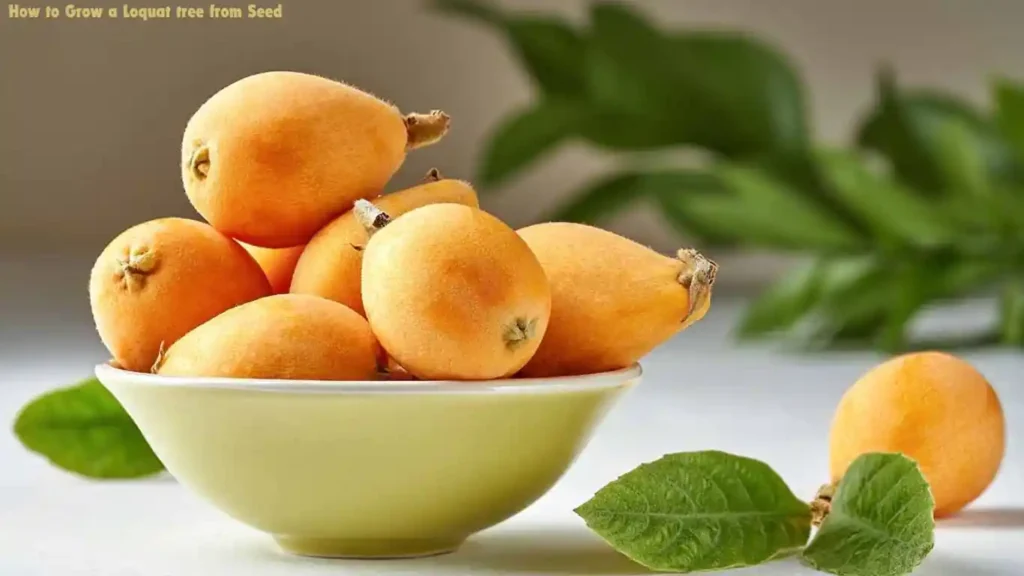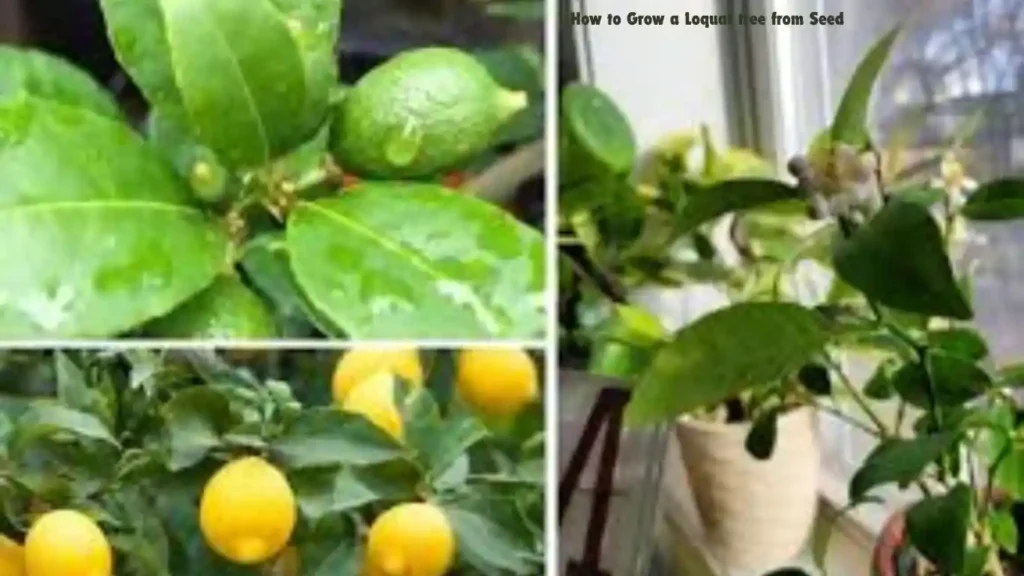How to Grow a Loquat tree from Seed Benefits & Care
How to Grow a Loquat tree from Seed makes a wonderful ornamental addition to a garden and provides not only fresh green foliage but also sweet fruits.
These evergreen trees grow in southern China and are cold hardy which makes a cup of tea ideal for the home gardener.
A loquat tree can be propagated from seed through the following steps which are described in detail in this guide.
Propagation of loquat through seeds is one of the best recommendations for people who want to grow trees for the production of fruit.
It is often cheaper than buying a young tree since it develops from a seed, and it is gratifying to grow your plant from the ground up.
Further, seed sowing presents a wider range of loquat cultivars that will allow you to let go of the flavor and characteristics that you want for your tree.
What Is a Loquat Tree?
One interesting fruit tree is the Japanese loquat – Eriobotrya japonica, which is a small evergreen tree with very decorative leaves and tasty fruits that are sweet-sour.
Usually growing 10 to 20 feet tall, it has lustrous, dark green leaves which are up to one foot in length. Loquat fruit, awning or similar in shape to a small pear, matures in spring and brimming with taste.
The loquat tree is native to southeastern China and has been grown for many years. They reached Japan, and became that nation’s favorite shoes, before moving in circles across the globe including the Mediterranean and the Americas.

It is a lovely fruit not only for the taste but also due to its resistance and rather easy to grow in many different conditions which can be beneficial for all garden lovers.
Benefits of Growing Loquat Trees
Pruning and constructing loquat trees may be greatly beneficial for them and for human health and nature in general.
This paper aims to establish the nutritional benefits of loquats. These fruits are privileged with vitamins A, C, and dietary fiber hence they should form part of our daily meals.
These changes can include enhancing the ability of your body to fight off diseases, improving digestion, and the health of your skin.
Consuming loquats may also contain other essential nutrients that have antioxidant importance to the human body.
Environmental Benefits: It is also important for people to know that loquat trees are beneficial to the environment.
They remain green throughout the year and as a result, contribute to enhancing air standards by removing carbon dioxide from the atmosphere.
Their big leaves also serve as homes and food for several birds and insects thus you get to add on the plant to improve the diversity of your garden.
Choosing the Right Seeds
The requirement of high-quality seeds is very important when one has to grow a tree from the seed generated from a loquat fruit.
How and Where to Get Good Loquat Seeds
You can get high-quality seeds at your local garden centers or by purchasing seeds from online stores or even from loquat fruits bought from a supermarket.
Make sure that you use fresh seeds, seeds that are not treated with chemicals as this hinders germination.
How to Choose the Right Seeds to Plant
Do not buy seeds that appear to be shriveled dried up, moldy, or in any way damaged.

The best seeds from loquats should be obtained from ripe ones as they are known to have a higher percentage of germination.
It is much easier to transplant a loquat seed that has a thick outer coat than seeds with low vitality.
Preparing the Seeds for Planting
There are several ways of preparing to plant your loquat seeds that will help increase the chances of germination.
How to Wash and Prepare Loquat Seeds
Begin by getting rid of the seeds in the ripe loquat fruit. To wash them, simply run them under running water until that ensures that all fruit residues are washed off.
This step is the best since any sugars remaining on the grain can lead to mold, which will slow germination. After washing, wait for a number of hours to give the seeds a chance to dry.
A few contenders have opted to tackle the optional issue of the importance of stratification.
Stratification is the process where conditions that are similar to those encountered in nature are created for the purpose of germinating seeds.
If you plan to plant loquat seeds you may wish to put the seeds in water for a day and then put the seeds in a soft damp paper in a polythene bag.
Refrigerate them for roughly a month. This cold treatment is however beneficial in enhancing germination, though it may not always be a must.
Germination Process
Sowing seeds is quite one of the significant activities when growing loquat trees and germinating your seeds is quite thrilling.
How to Germinate Loquat Seeds
Finally, plant these seeds 1 inch deep in a pot that has a well-draining sowing mix of compost or soil.
You have to water it carefully just enough to moisten the soil but not to the point of overly flooding.
The above was covered with plastic wrap in order to create a sort of greenhouse that would ensure the point is moist and warm for its needs.
Factors That Determine Germination Percentages and Rate
How to Grow a Loquat tree from Seed in Warm and moist conditions favoring a Tropical Region. try to keep the pot in a warm area of your house, the best temperature should be between 70-85F, and 21-29C.

Make sure it is moist but not waterlogged and ensure you check it frequently to ensure that it remains moist.
It may take some weeks for seeds to germinate, they should require patient and stable environmental conditions.
Choosing the Right Soil
Planting seeds is rather one of the paramount tasks when cultivating loquat trees and sprouting your seeds is half the fun.
How to Germinate Loquat Seeds
Last of all, you have to plant these seeds, at least one inch deep in a pot that has the right sowing mix of compost or soil.
You have to water it correctly, this means that you have to wet the soil without having to overly saturate them.
The above was covered with plastic wrap in order to create a sort of greenhouse that would ensure the point is moist and warm for its needs.
Influences of percent germination and rate of germination
How to Grow a Loquat tree from Seed requires warm and moist conditions, best suitable for a tropical climate, so try to place the pot in a warm part of your house, the best temperature should range between 70-85F and 21-29 C.
Ensure that it was moist but not waterlogged and make sure to check it frequently so that we ensure that it remains moist.
This may take some weeks before seeds germinate therefore, it should require patience and C3 stable environmental conditions.
Planting Loquat Seeds
If you want to grow your loquat seeds properly, it is necessary to plant them properly.
Twelve Easy Steps to Planting
Prepare the Pot: Put a pot with the well-draining soil mix you used when creating it earlier.
Plant the Seeds: Plant the seeds to about an inch below the surface of the soil.
Water: Then sprinkle the seeds lightly to help them set the soil around the seeds.
Cover: Optionally the pot may be covered with a plastic wrap as this keeps the vegetables moist.
Field seed spacing and depth: The guide to better practices If you are sowing several seeds in the same growing container, it is necessary to leave about 3 to 4 inches between each seed.
Make sure that you plant aubergines at an appropriate depth—Americaniers suggest first one inch to reduce the risk of aubergine’s roots drying out and to help the roots become sturdy.
Watering and Care During Seedling Stage
It is necessary to take good care of your loquat tree specifically through the seedling stage in order to achieve proper growth.
The Need to Water Young Plants
The water requirement of loquat seedlings is moderate, but avoid watering them too often. Water the plant occasionally; the soil should not be wet but moist.
Irrigate the seedlings only when the soil at their base feels dry, at least to the first knuckle when you touch it. It is helpful to form good roots while avoiding root rot at the same time.
Making Sure Your Pet Gets The Right Attention At A Young Age
Besides watering, offer the seedlings with the required light. Put them in a location that doesn’t expose them to direct sunlight but they should be under a little filtered sunlight.
With little time, stretch towards the light is apparent, then you can then need more light.
Look for pest and disease pressure because plants at this stage can be sensitive to attack.
conclusion
It takes some time to grow a loquat tree from seed, and even more, time to cultivate it with the necessary care, in fact, observing the battle and process it is exciting.
Be patient to realize that it may take 3-4 years before the tree produces fruits, take time and enjoy the process of growing the new tree.
FAQS
Is loquat easy to grow?
Loquat is a great addition as a garden tree because it is a low-maintenance tree that produces lovely foliage which is so important as a statement tree.
Can loquats be grown indoors?
Flood-resistant and able to withstand storms, heat, and many soil conditions, Loquats, otherwise referred to as Japanese Plums are best grown outside but excel indoors. In fact, Loquat only requires as well-drained soil as well as much water as it can get.
Do loquat trees like water?
Although the loquat is highly drought tolerant for a wide-leaved evergreen, it requires water at all times, especially during the summer period. Once the trunk has been developed avoid directing water towards it as this might cause rotting.
Why are loquats not sold in stores?
This fruit is very soft and turns bad very fast, it cannot be sold for commercial purposes it would be such a waste of resources. Loquats may be available in your local farmer’s markets Source:www.freshfruitsandvegetables.com/fruit/Loquat.htm In California, the fruit begins to ripen during the time of April through to the middle of the year May.
Are loquats hard to grow?
Even though loquats, are tropical/sub-tropical, they do very well way up north of their ideal climate area. It can even withstand very low temperatures applied to them without much signs of damage. In my opinion and practice, they are definitely harder than figs.
Also Read
- How to Grow a Tree from a Seed
- How to Grow Guava from Seed
- How to Grow Tamarind from Seed
- How to Grow Catnip from Seed
- How to Grow Cactus from Seed
